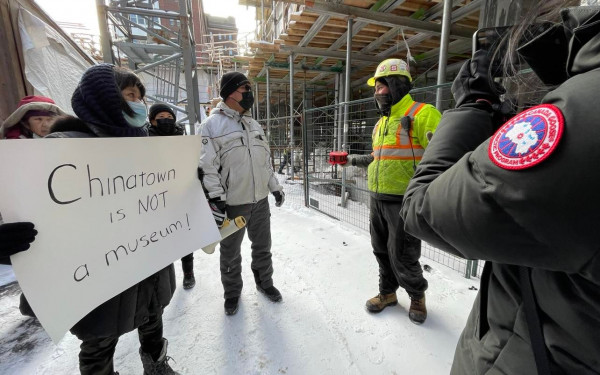‘Revitalizing’ The Point
Development projects forcing Point St. Charles Residents to Find a New Home
Like most residents of Point St. Charles, Sue Vaughn is a tenant. She rents an apartment in the same building as her daughter and four grandchildren on Reading Street.
Since the early 2000s when the southwest Montreal neighbourhood was revitalized with the reopening of the Lachine Canal, property values on Vaughn’s street have climbed by as much as 600 per cent.
Faced with the prospect of cashing in on six-figure profits, Vaughn’s landlord has put her building up for sale.
“Either [the new owners] will renovate and our rent will nearly double, or they’ll want to live in the building,” said Vaughn, who has lived in Point St. Charles since the 1980s. “One way or the other we’re being uprooted.”
For the past five years, houses along Reading Street—which is bordered by a freight train line, the Champlain Bridge Expressway and an ice factory—have been sold, gutted, renovated and resold for profit, causing families that have lived in the area for generations to look towards LaSalle, Verdun or even Chateauguay for affordable housing.
The situation on Reading is symptomatic of a much larger phenomenon in the once thriving industrial borough. After the Lachine Canal was reopened in 2002, developers began buying up condemned factories and warehouses to turn them into high-end condos.
Although development projects have brought money into a struggling neighbourhood, they have also largely excluded locals from the decision-making process and made it nearly impossible for them to own property in the Point and in neighbouring Griffintown.
The influx of upper middle-class residents has not done much to help local business. Pedestrians taking a walk along Center Street are greeted with entire blocks of boarded up buildings which were once occupied by locally owned grocery stores and variety shops. Most new residents take advantage of the Point’s proximity to the Atwater Market across the canal.
Two of the latest mega projects to hit the South West, spearheaded by the Samcon and Devimco development companies, are meeting opposition from community groups and academics.
On Sept. 15, Point St. Charles community organizer John Bradley led Columbia University urban planning professor Peter Marcuse on a walking tour of the South West.
“We wanted to give Marcuse a taste of what issues we face in Point St. Charles and Griffintown,” he said.
Bradley began the tour on the east side of Point St. Charles, where Samcon is expanding its condo construction into the vacant Canadian National Railway yards.
Seventy-eight per cent of Point St. Charles residents are renters. Of those renters, 71 per cent have an annual household income of less than $40,000 and could not afford to buy one of Samcon’s cheapest condo models, which costs over $160,000.
Twenty-five per cent of Samcon’s developments are reserved for social housing.
According to Bradley, this hardly addresses the needs of the community, where 40 per cent of renters depend on some form of subsidized housing and another 1,400 people are currently on a waiting list for similar services.
Bradley then led Marcuse along Sebastopol Street, past a scrap metal yard, a mechanic’s shop, one of the city’s last functional stables, and into Griffintown where Devimco will begin construction on a $475 million development called District Griffin later this year.
The project consists of three condo buildings and a 19-storey hotel and office building that will have stores on the ground floor. Martin, Marcotte et Beinhaker—a Montreal architecture firm that designed strip malls on the South Shore—drew the building plans for District Griffin.
“I look at the images of these buildings the developers show everyone and I call it edifice complex,” said Bradley.
Devimco’s announced plans include 275 social housing units along with an additional 205 affordable units in District Griffin, but for the most part condo prices will range from between $250,000 to $750,000. Although the developers have scaled back the billion-dollar proposal they made public in 2007, Marcuse said District Griffin would still have a huge impact on the area.
“It doesn’t matter how they changed it,” he said. “It’s going to drive the prices [of real estate] up either way.”
Bradley is determined to reach a compromise with developers however he has to. When the city of Montreal tried to approve the construction of a multi-million dollar casino in the Point in 2006, Activist group Action Gardien helped mobilize citizens against it.
Residents turned activists adorned stores, houses, telephone poles and concrete walls with anti-casino signs and graffiti, sending a clear message to city hall. Ultimately, the project was met with so much opposition from locals that it was scraped entirely.
“If people really feel they need to, we can get up to about a thousand of them in the streets protesting,” said Bradley.
Some families still have deep roots in the Point, tracing their ancestry back to the Irish immigrants that dug the Lachine Canal by hand in the early 1800s. But for the Vaughn’s, who came to South West borough to live in an affordable English-speaking environment, their future in the neighborhood is largely out of their hands.
They will wait for their new landlord to declare his or her intentions, at which point they will likely have to move further from the city and away from a place they called home for nearly 30 years.
For Sue Vaughn, it means learning new bus routes, making a further trek to the grocery store and potentially living far from the grandchildren she cares for on a daily basis.
“It’s not revitalization,” said Vaughn. “It’s just kicking out the workers, the people who made this area what it is.”
This article originally appeared in Volume 31, Issue 06, published September 21, 2010.


__700_1050_90.jpg)
_600_832_s.png)




